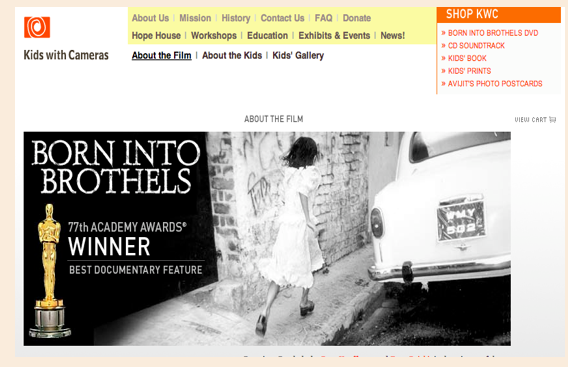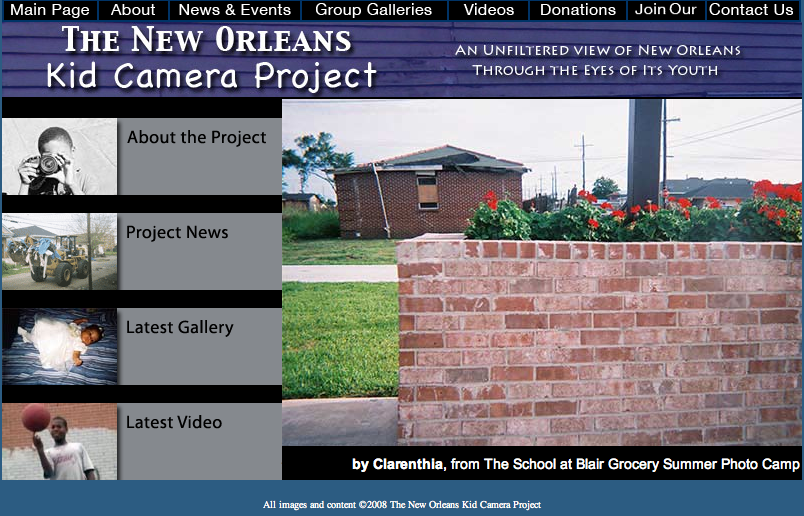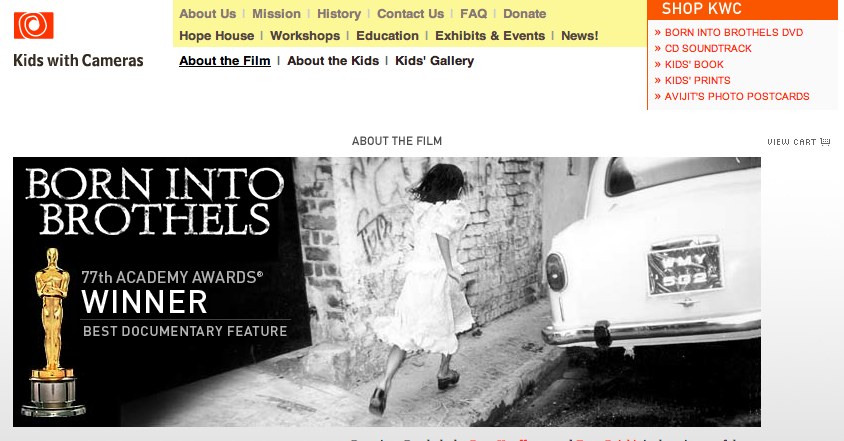
Image Credit: Screenshot of viz.
This past week, I had the privilege of listening to Susan B.A. Somers-Willett, Natasha Trethewey, and Kwame Dawes give a reading/ panel at AWP on their work that I have discussed in recent posts (here and here). The panel was moderated by VQR editor Ted Genoways and also included the poet Erika Meitner who is currently collaborating with a photographer on a project involving Detroit. I'm preparing a longer, related post to appear in the coming weeks, but, in the meantime, I've been thinking about issues of representation raised by those pieces and how the combined effect of literary and visual gazes transforms the stakes for subject, viewer, poet, photographer, and editor. In that frame of mind, I'm re-booting Andi Gustavson's provacative post on the power dynamics of documentary films that feature children. Writing about Born into Brothels, Andi is concerned with how "the viewer is
invited into the film in a position of power." Surely, such a consideration can be extended to the "readers" of these projects.
Start of Andi's original post:

Image credit: screen shot of The New Orleans Kids with Camera Project
For our class on social documentary
film, we screen Martin Bell’s Streetwise—a
documentary that follows young homeless kids through their daily routines. Our class discussion always considers
the question of consent and the issue of exploitation with subjects who are so
young. This is an issue that
always arises when there are cameras trained on kids—recently, however, we also
considered the question of training kids to work with cameras. Over the last several years there have
been many projects that seek to empower children by providing them with cameras
and an opportunity to discuss their artwork. The New Orleans Kid
Camera Project attempts to offer an
“unfiltered view of New Orleans through the eyes of its youth.” These organizations— for instance, Kids
with Cameras and The New Orleans
Kid Camera Project and films like Born
into Brothels—are surely providing an
excellent experience for young people who might not otherwise have had access
to cameras and a space to discuss artwork. Although these projects that provide
kids with cameras claim to offer a therapeutic experience for participants and
access to an innocent vision through the photographs for viewers, many of the
issues of consent and exploitation are still at play here.

Image credit: screen shot of website for Born into Brothels
In
one of the opening scenes of Zana Briski and Ross Kauffman’s 2005 documentary
film Born into Brothels, an
eleven-year-old girl introduces the viewer to her fellow student and
herself. She is smiling, and
obviously at ease on film. The
camera angle is direct, shot at the same level as this young girl. As she narrates the film cuts away to
still photographs of the children she is naming. The narration, the angle, the sequencing here all seem to
suggest that it is Puja and the other children born to prostitutes in
Calcutta’s red light district that are in control of their representation. Certainly Briski and Kauffman’s attempt
to empower their subjects by handing over the camera contributes to the sense
that this film is an example of unmediated, self-representation and that as
such, the film mitigates those power dynamics that typically arise in social
documentary photojournalism.
Born
into Brothels seems at first to solve some
of the disparities in power by inverting the expected relationships of
photographer and subject; the young children to which the title refers are
given cameras, the filmmaker appears often on screen. However, this documentary does very little self-reflexive
questioning of the methods of representation. Rather this film seems to suggest that this inversion
provides access to an objective truth.
In many ways, Born into Brothels is a respectful, sensitive portrayal of many of these children. In fact, Briski and Kauffman go well
beyond the typical level of involved, concerned filmmakers to alleviate the
situation of their subjects.
Viewers of the film and the film’s website are encouraged to purchase
signed prints of the children’s photographs with all of the proceeds going
towards their education. Simply because it does a better job than most
documentary films at attempting to avoid exploitative situations, does not mean
that this representations is unproblematic.
Right
from the start, and despite Puja’s seeming narrative control, the viewer is
invited into the film in a position of power. There are very few scenes of adults taking care of these
kids and so the film asks us to protect them. As Puja tells the camera she will have to join the line of
prostitutes and “they say it will be soon” the film encourages the viewer to
alleviate her situation. Because
the film introduces each child through his or her photographs juxtaposed with
scenes of that child in Briski’s photography class, the film offers the viewer
a powerful vantage point similar to that of the teacher who must recognize the
talent in each child (especially Avijit) and then validate that talent. Setting aside questions concerning the
voyeurism that surrounds a filmic excursion into the red light district of a
foreign country, and questions concerning permission when documenting the lives
of such young people, Born into Brothels
still seems problematic in its presentation of the poverty of its
subjects. Because the film focuses
solely on these few children and what can be done to change their lives, Born
into Brothels implies that if the viewer
watches, understands, and perhaps contributes to their college funds then all
pictured problems will be alleviated.
There is no attention paid to the broader structural issues that have
created the situation in the first place and no attention is given to any
grassroots organizations that may be working to address the same problems in
Calcutta’s red light district.
This film privileges a model of missionary work in which a white Western
woman enters into the third world to save her subjects. It seems that offering the camera to
the subject does not entirely alleviate the filmmaker from the burden of
representation.



Recent comments
2 years 29 weeks ago
2 years 44 weeks ago
2 years 44 weeks ago
2 years 50 weeks ago
3 years 4 weeks ago
3 years 4 weeks ago
3 years 4 weeks ago
3 years 6 weeks ago
3 years 6 weeks ago
3 years 6 weeks ago